线程安全性是Java等语言/平台中类的一个重要标准,在Java中,我们经常在线程之间共享对象。由于缺乏线程安全性而导致的问题很难调试,因为它们是偶发的,而且几乎不可能有目的地重现。如何测试对象以确保它们是线程安全的?
假如有一个内存书架
package com.mzc.common.thread;
import java.util.Map;
import java.util.concurrent.ConcurrentHashMap;
/**
* <p class="detail">
* 功能: 内存书架
* </p>
*
* @author Moore
* @ClassName Books.
* @Version V1.0.
* @date 2019.12.10 14:00:13
*/
public class Books {
final Map<Integer, String> map = new ConcurrentHashMap<>();
/**
* <p class="detail">
* 功能: 存书,并返回书的id
* </p>
*
* @param title :
* @return int
* @author Moore
* @date 2019.12.10 14:00:16
*/
int add(String title) {
final Integer next = this.map.size() + 1;
this.map.put(next, title);
return next;
}
/**
* <p class="detail">
* 功能: 根据书的id读取书名
* </p>
*
* @param id :
* @return string
* @author Moore
* @date 2019.12.10 14:00:16
*/
String title(int id) {
return this.map.get(id);
}
}
首先,我们把一本书放进书架,书架会返回它的ID。然后,我们可以通过它的ID来读取书名,像这样:
Books books = new Books(); String title = "Elegant Objects"; int id = books.add(title); assert books.title(id).equals(title);
这个类似乎是线程安全的,因为我们使用的是线程安全的ConcurrentHashMap,而不是更原始和非线程安全的HashMap,对吧?我们先来测试一下:
public class BooksTest {
@Test
public void addsAndRetrieves() {
Books books = new Books();
String title = "Elegant Objects";
int id = books.add(title);
assert books.title(id).equals(title);
}
}
查看测试结果:
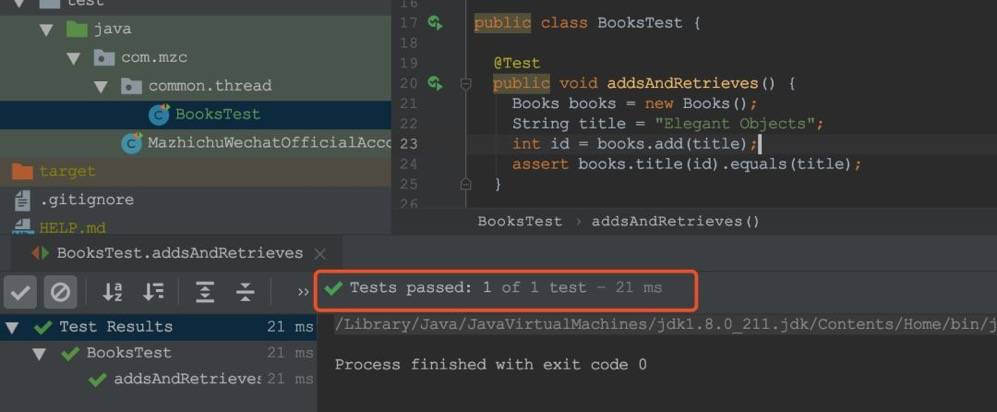
测试通过了,但这只是一个单线程测试。让我们尝试从几个并行线程中进行相同的操作(我使用的是Hamcrest):
/**
* <p class="detail">
* 功能: 多线程测试
* </p>
*
* @throws ExecutionException the execution exception
* @throws InterruptedException the interrupted exception
* @author Moore
* @date 2019.12.10 14:16:34
*/
@Test
public void addsAndRetrieves2() throws ExecutionException, InterruptedException {
Books books = new Books();
int threads = 10;
ExecutorService service = Executors.newFixedThreadPool(threads);
Collection<Future<Integer>> futures = new ArrayList<>(threads);
for (int t = 0; t < threads; ++t) {
final String title = String.format("Book #%d", t);
futures.add(service.submit(() -> books.add(title)));
}
Set<Integer> ids = new HashSet<>();
for (Future<Integer> f : futures) {
ids.add(f.get());
}
assertThat(ids.size(), equalTo(threads));
}
首先,我通过执行程序创建线程池。然后,我通过Submit()提交10个Callable类型的对象。他们每个都会在书架上添加一本唯一的新书。所有这些将由池中的10个线程中的某些线程以某种不可预测的顺序执行。
然后,我通过Future类型的对象列表获取其执行者的结果。最后,我计算创建的唯一图书ID的数量。如果数字为10,则没有冲突。我使用Set集合来确保ID列表仅包含唯一元素。
我们看一下这样改造后的运行结果:
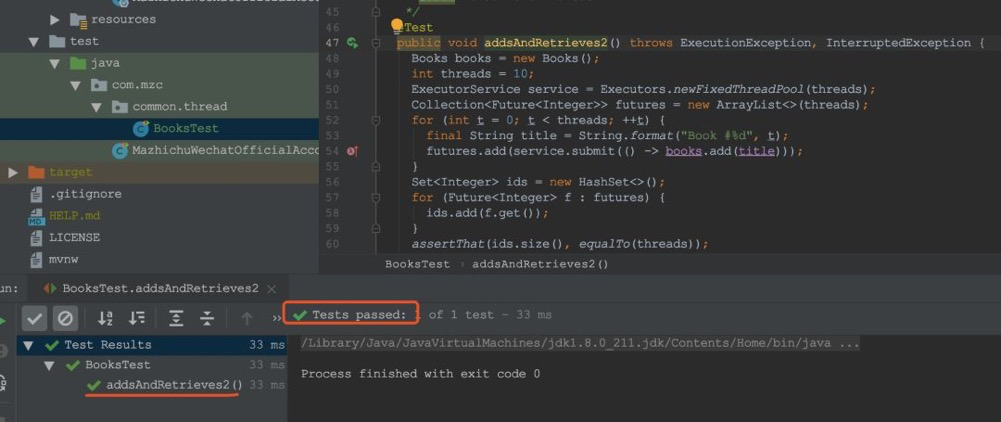
测试也通过了,但是,它不够强壮。这里的问题是它并没有真正从多个并行线程测试这些书。在两次调用commit()之间经过的时间足够长,可以完成books.add()的执行。这就是为什么实际上只有一个线程可以同时运行的原因。
我们可以通过修改一些代码再来检查它:
@Test
public void addsAndRetrieves3() {
Books books = new Books();
int threads = 10;
ExecutorService service = Executors.newFixedThreadPool(threads);
AtomicBoolean running = new AtomicBoolean();
AtomicInteger overlaps = new AtomicInteger();
Collection<Future<Integer>> futures = new ArrayList<>(threads);
for (int t = 0; t < threads; ++t) {
final String title = String.format("Book #%d", t);
futures.add(
service.submit(
() -> {
if (running.get()) {
overlaps.incrementAndGet();
}
running.set(true);
int id = books.add(title);
running.set(false);
return id;
}
)
);
}
assertThat(overlaps.get(), greaterThan(0));
}
看一下测试结果:
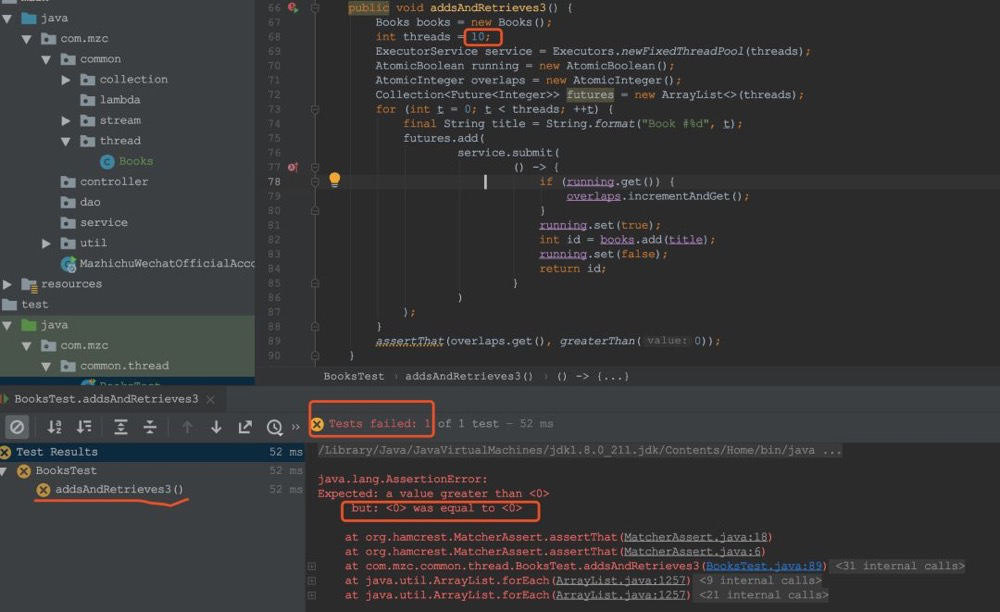
执行错误,说明插入的书和返回的id数量是不冲突的。
通过上面的代码,我试图了解线程之间的重叠频率以及并行执行的频率。但是基本上概率为0,所以这个测试还没有真正测到我想测的,还不是我们想要的,它只是把十本书一本一本地加到书架上。
再来:
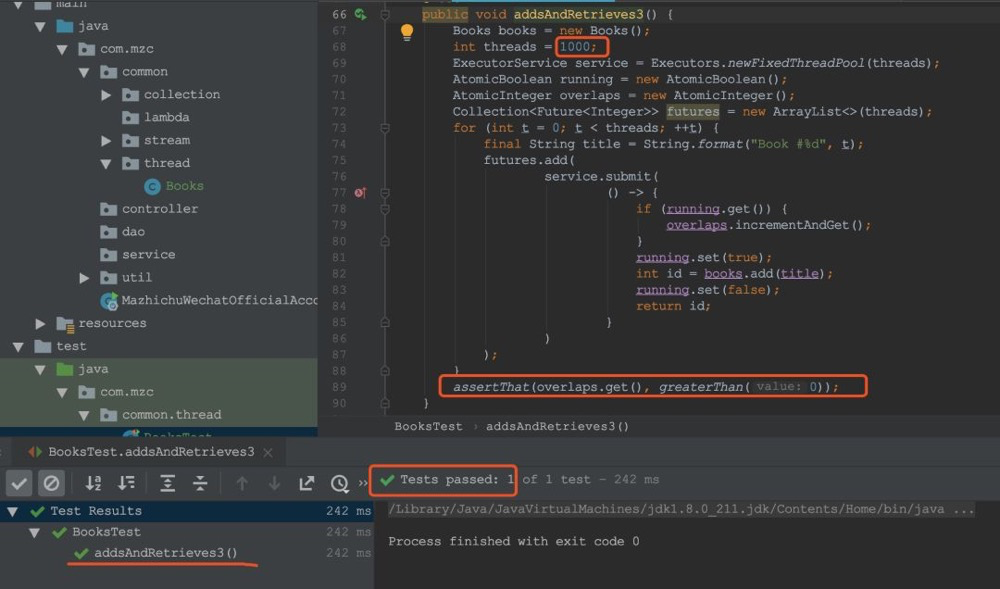
可以看到,如果我把线程数增加到1000,它们会开始重叠或者并行运行。
但是我希望即使线程数只有10个的时候,也会出现重叠并行的情况。怎么办呢?为了解决这个问题,我使用CountDownLatch:
@Test
public void addsAndRetrieves4() throws ExecutionException, InterruptedException {
Books books = new Books();
int threads = 10;
ExecutorService service = Executors.newFixedThreadPool(threads);
CountDownLatch latch = new CountDownLatch(1);
AtomicBoolean running = new AtomicBoolean();
AtomicInteger overlaps = new AtomicInteger();
Collection<Future<Integer>> futures = new ArrayList<>(threads);
for (int t = 0; t < threads; ++t) {
final String title = String.format("Book #%d", t);
futures.add(
service.submit(
() -> {
latch.await();
if (running.get()) {
overlaps.incrementAndGet();
}
running.set(true);
int id = books.add(title);
running.set(false);
return id;
}
)
);
}
latch.countDown();
Set<Integer> ids = new HashSet<>();
for (Future<Integer> f : futures) {
ids.add(f.get());
}
assertThat(overlaps.get(), greaterThan(0));
}
现在,每个线程在接触书本之前都要等待锁权限。当我们通过Submit()提交所有内容时,它们将保留并等待。然后,我们用countDown()释放锁,它们才同时开始运行。
查看运行结果:
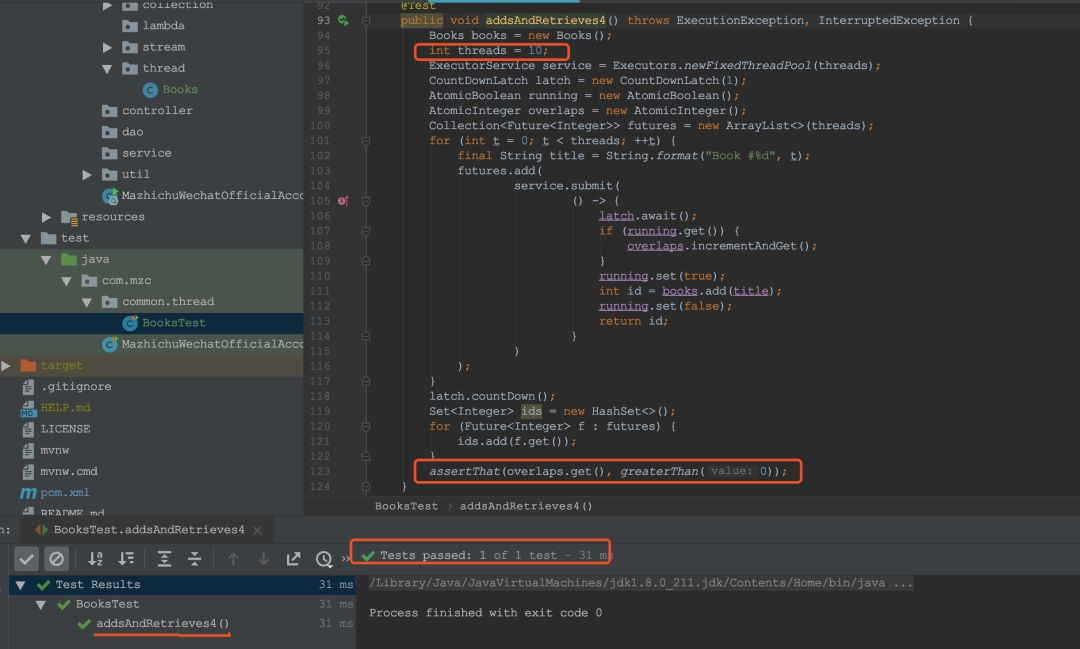
通过运行结果可以知道,现在线程数还是为10,但是线程的重叠数是大于0的,所以assertTrue执行通过,ids也不等于10了,也就是没有像以前那样得到10个图书ID。显然,Books类不是线程安全的!
在修复优化该类之前,教大家一个简化测试的方法,使用来自Cactoos的RunInThreads,它与我们上面所做的完全一样,但代码是这样的:
@Test
public void addsAndRetrieves5() {
Books books = new Books();
MatcherAssert.assertThat(
t -> {
String title = String.format(
"Book #%d", t.getAndIncrement()
);
int id = books.add(title);
return books.title(id).equals(title);
},
new RunsInThreads<>(new AtomicInteger(), 10)
);
}
assertThat()的第一个参数是Func(一个函数接口)的实例,接受AtomicInteger(RunsThreads的第一个参数)并返回布尔值。此函数将在10个并行线程上执行,使用与上述相同的基于锁的方法。
这个RunInThreads看起来非常紧凑,用起来也很方便,推荐给大家,可以用起来的。只需要在你的项目中添加一个依赖:
<dependency>
<groupId>org.llorllale</groupId>
<artifactId>cactoos-matchers</artifactId>
<version>0.18</version>
</dependency>
最后,为了使Books类成为线程安全的,我们只需要向其方法add()中同步添加就可以了。或者,聪明的码小伙伴们,你们有更好的方案吗?欢迎留言,大家一起讨论。
文章同步公众号:码之初,每天推送Java技术文章,期待您的关注!
原创不易,转载请注明出处,谢谢!